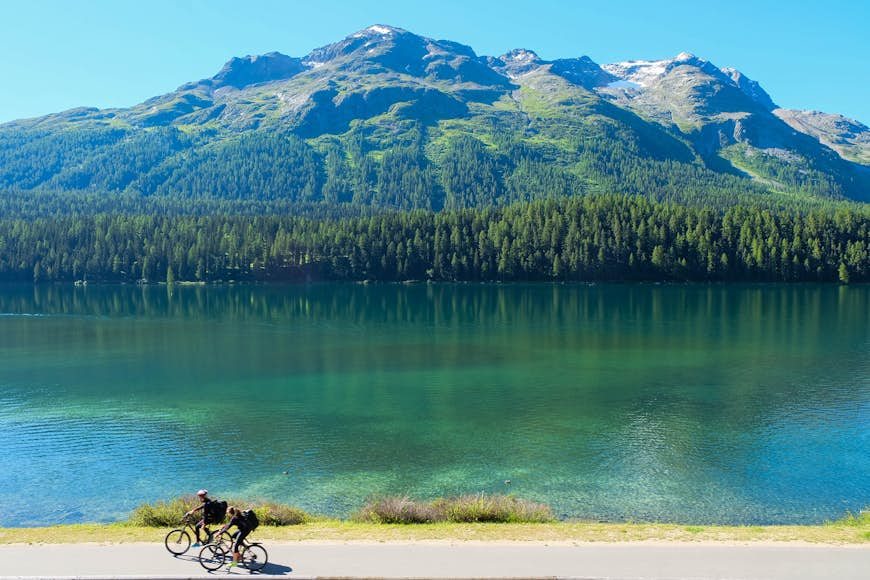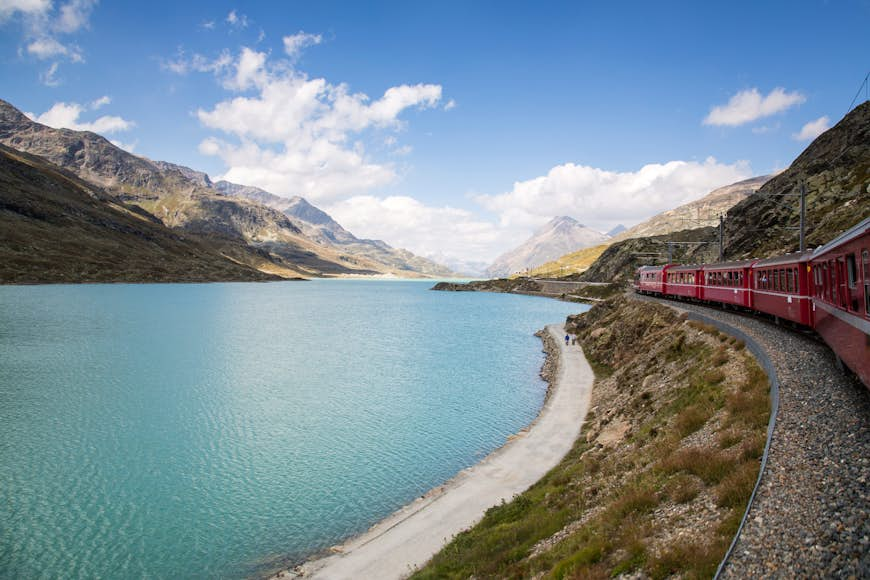The old maxim that the journey is the destination rings true in Switzerland. It’s a country of scenic hairpin-bend road trips, train lines that hole out the Alps like Swiss cheese and dreamy boat journeys across crystalline lakes.
Travel in Switzerland isn’t only beautiful – it’s also environmentally sound. The eco-minded Swiss have nailed rail travel like no other nation, and climate-neutral boats, solar-powered cable cars, electric buses and car-free towns and resorts further boost its sustainable credentials. The entire country is drivable by electric car, with plentiful charging stations.
Journeys in Switzerland aren’t just about getting from A to B – they are travel moments you’ll be raving about for years to come.
Watch stunning scenery go by when traveling by train in Switzerland
You’ve got to hand it to the Swiss – their trains really are the dream: efficient, slickly modern, eco-friendly and with views that keep you glued to the window for the entire duration of the journey. The famous panorama tourist trains (with big windows) are just tip-of-the-iceberg stuff: regular scheduled services, which often ply the same routes as the tourist trains, can be just as enjoyable and significantly less expensive.
Most major cities, including Bern, Geneva, Zurich and Basel, are connected by rail with daily services. Tickets do not need to be bought in advance, and they can be purchased at stations on the day of travel or on the official Swiss Railways website. That said, look out for sizable discounts when booking “supersaver” tickets ahead of travel.
Switzerland’s panoramic trains
Primarily aimed at tourists, these named panoramic trains often have cars with extra large windows to make the most of the incredible scenery. They all require reservations, with tickets usually sold for a specific leg on the routes rather than the full journey.
- Glacier Express: The wow never leaves your lips on this legendary Alpine train journey between Zermatt and St Moritz. The Brig–Zermatt Alpine leg makes for pretty powerful viewing, as does the area between Disentis/Mustér and Brig.
- GoldenPass Line: Skirting the shores of some of Switzerland’s most ravishing lakes, this route links Lucerne to Montreux. The journey is in three legs, and you must change trains twice. Regular trains, without panoramic windows, work the whole route hourly.
- Bernina Express: Negotiates 55 tunnels and 196 bridges as it travels between Engadine one way from Chur to Tirano in four hours, hitting its high point at 2253m (7392ft) above sea level. Between May and October, you can continue from Tirano to Lugano by bus.
- Mont Blanc/St Bernard Expresses: From Martigny to Chamonix, France, or over the sensationally wild St Bernard Pass.
- Voralpen Express: Glides between Lake Constance and Lake Lucerne, through St Gallen, Rapperswil and Romanshorn.
- Gotthard Panorama Express: This rail-boat combo starts with a wonderful 2.5-hour cruise across Lake Lucerne to Flüelen, from where a train winds its way through ravines and past mountains to Bellinzona or Lugano.
Driving in Switzerland is a breeze
Skirting lakes and vineyards and twisting up and over passes in the high Alps, Switzerland’s roads are beautiful on a cinematic scale, and the country has plenty of drives that are too darned scenic to rush.
The headline road trip is the 1600km (994-mile) Grand Tour of Switzerland, an epic, efficiently signposted lap of the country that links 12 Unesco World Heritage Sites and shows off the Alpine nation from its most flattering angles. And the environmental clincher? It’s entirely drivable by electric car.
You’ll find car rental companies at airports and in cities and towns. Many now rent out electric cars, too. The minimum rental age is usually 25 but falls to 20 at some local firms. You always need a credit card. In winter, rental cars are usually equipped with winter tires.
You’ll need to pay an annual one-time charge of Sfr40 to use Swiss freeways and semi-freeways, identified by green signs. The charge is payable (in cash, including euros) at the border, at Swiss gas stations, post offices and at Swiss tourist offices abroad. Upon paying the tax, you’ll receive a sticker that must be displayed on the windshield.
Switzerland’s roads are well signposted and maintained, but you should always check conditions before heading up into the Alps, especially in winter. The highest passes are only open from June to October and, depending on the weather, you may need to use a tunnel instead.
Take a slower route on the bus
If you are in no hurry, Switzerland’s bright yellow postal buses can be a fun way to reach the remote mountain regions. The country’s PostBus service is synchronized with train arrivals, and bus stops are handily located right next to railway stations.
Prices are comparable to train fares. Swiss national travel passes are valid, but a few tourist-oriented Alpine routes levy a surcharge. Tickets are purchased from the driver, though on some scenic routes over the Alps (for instance the Lugano to St Moritz run) reservations are necessary.

Get to the summit on a mountain railway
What a way to commute! The cable cars, funiculars, cogwheel railways and gondolas that climb up to the country’s highest Alpine reaches are an absolute joy to experience and a highlight of traveling in Switzerland (as long as you have a head for heights!).
True marvels of engineering, the mountain gondolas graze treetops, rail-bound funiculars shimmy precariously close to rock faces, and cable cars wobble across valleys (don’t worry – they are safe and subject to regular checks), before all emerge at a spectacularly snowy summit or glacier. It’s worth checking out what money-saving passes are available locally because they often work out cheaper than individual tickets and costs can quickly mount up in a country with so much vertical.
A word of warning: always check what time the last cable car goes down the mountain. In winter, it’s as early as 4pm in mountain resorts.
Boat cross Switzerland’s lakes
Switzerland is a land-locked country, but boats ply the country’s large lakes, serviced by steamers operated by Swiss Federal Railways or private companies for which national travel passes are valid.
Passenger boats run on Lake Geneva, Constance, Lucerne, Lugano, Neuchâtel, Biel, Murten, Thun, Brienz and Zug. Traveling by boat is a slow and delightfully scenic way to get around.
Transport passes in Switzerland
Though travel in Switzerland is efficient and convenient, it can also be expensive, and visitors planning to use inter-city routes should consider investing in a Swiss Travel Pass. With this transport pass, you’re allowed unlimited travel by train (including premium panorama trains), bus and boat, as well as local public transportation in cities and free entry to 500 museums.

Ride a bicycle to experience Switzerland up close
Whether you’re looking to crawl up hills on a road bike, tear down trails on a mountain bike or simply want a gentle pedal along a shimmering lake, Switzerland is brilliantly set up for cyclists. Many cities have free or inexpensive bike-rental schemes, and bicycle and e-bike rental is usually available at train stations.
Switzerland is a fantastic country for two-wheel adventures, with many well-signed and highly scenic cycle routes heading along rivers and lakeshores. For details on national, regional and local routes, rental (including e-bike rental), bike-friendly accommodations, guides and maps, check SwitzerlandMobility.
Bikes can be taken on slower trains, and sometimes even on InterCity (IC) or EuroCity (EC) trains, when there’s room in the luggage carriage. Advance booking is sometimes necessary.
Accessible transportation in Switzerland
Switzerland ranks among the world’s most easily navigable countries for travelers with physical disabilities. Most train stations have a mobile lift for boarding trains, and city buses are equipped with ramps. The majority of modern hotels also have wheelchair access (although budget accommodations tend not to have elevators).
Switzerland Tourism has excellent travel tips for people with physical disabilities or get in touch with Procap, an authority on barrier-free travel in Switzerland.
For more helpful travel tips, download Lonely Planet’s free Accessible Travel guide.
